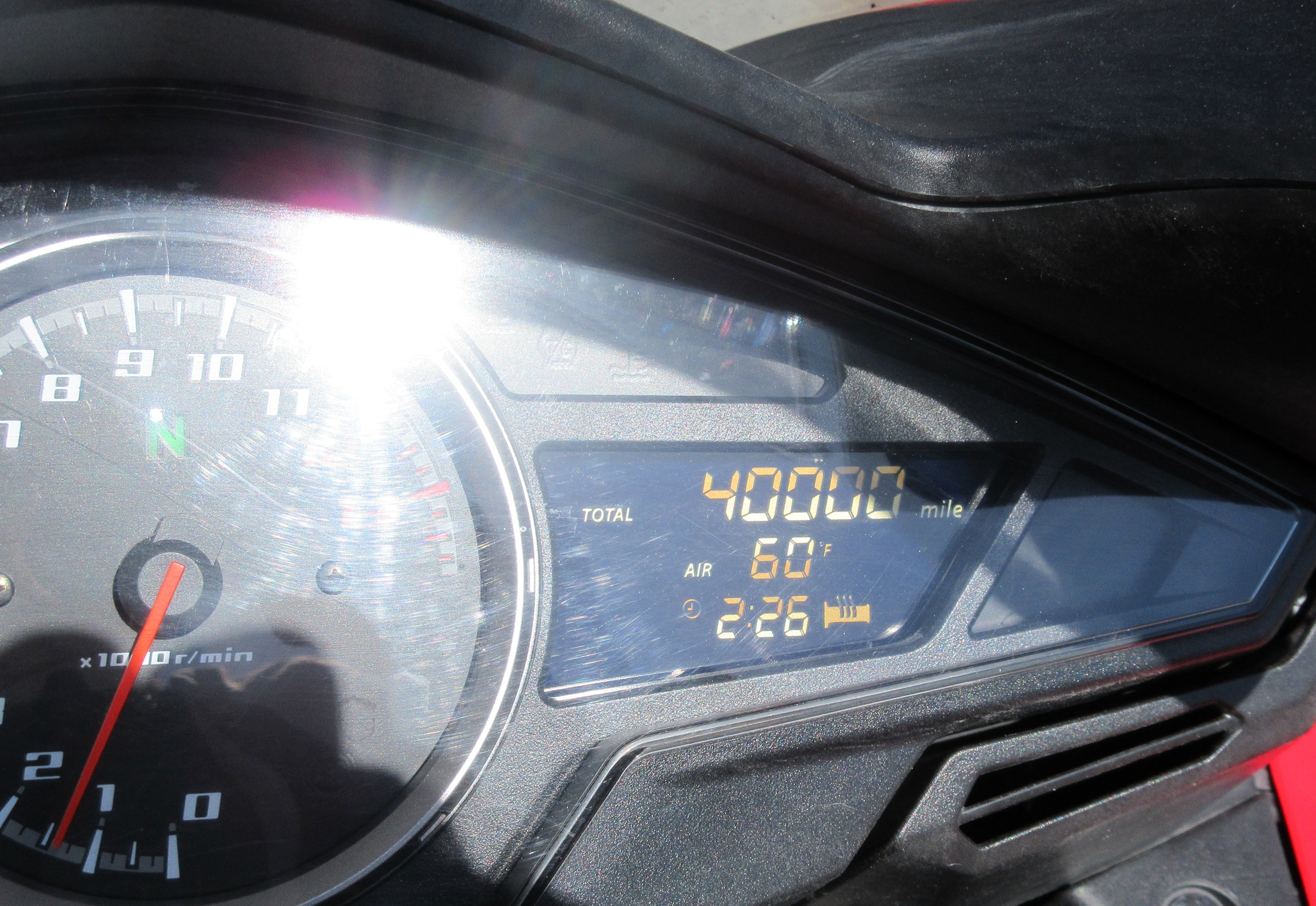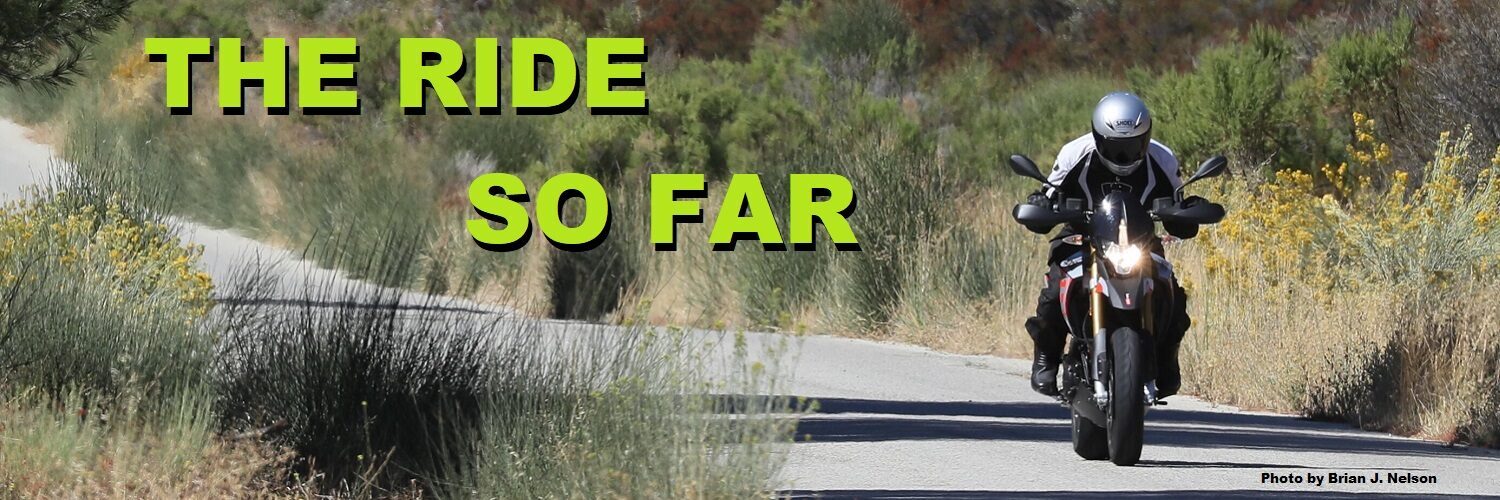Down to two motorcycles these days, something dawned on me recently when my “new” motorcycle, the one deemed reliable for long-distance travel, rolled over 40,000 miles. That means the average mileage on my two motorcycles is now well above 80,000 miles.
In a country where most people ride a couple of thousand miles a year, mostly heading out for recreational rides on summer weekends when the weather is right, I’ve always been an oddball. The fact that I’ve relied on motorcycles for my primary transportation needs for the past 30-plus years is just one way I’m atypical, by U.S. riding standards. There are others. Here are three.

My 2014 Honda VFR800 Interceptor Deluxe rolled over recently.
How many miles I ride: Steady adds up
How did I end up with average mileage of more than 80,000 miles on my small fleet of two? For me, it’s simply a matter of time. I’m not out doing Iron Butt rides, but I do ride regularly. I ride for personal transportation, take a few trips a year, and rarely but occasionally take a ride just for fun. Do that consistently and keep your motorcycles long enough and the mileage adds up.
I bought my 2014 Honda VFR800 Interceptor Deluxe at the dawn of the pandemic with 9,013 miles on the odometer. So its original owner rode it about 1,500 miles a year. I hunted down a rare set of the original panniers, which are no longer available from U.S. dealers, and since then it’s been my traveling bike. After a recent trip to Road Atlanta, it reached 40,000 miles. For about a year and a half, it was functionally my only bike, when we moved to the Boston area and I had limited garage space. But after moving to the Berkshires in western Massachusetts, I retrieved my 1997 Triumph Speed Triple from storage, so I’m back to two.
The 1997 Speed Triple I bought used in 1998 with 6,259 miles on the odometer. In recent years, it has been in semi-retirement, doing light-duty local runs, in addition to spending a little time in storage due to my move. It still runs well, but I don’t plan to try any more long-distance trips on it. So there were years when it was hardly used, and some years when it was my main transportation and I probably put 10,000 miles on it alone. Apparently, if you keep doing that for 26 consecutive years you end up with quite a few rotations on the odometer without even trying, so now, it’s knocking on the door of 122,000 miles. Thus, the average of the two is about 81,000 miles.

This is the moment six years ago when I’d put a legitimate 100,000 miles on the Speed Triple myself. I added the homemade “1” earlier, when it hit six-digit mileage. I guess the original Triumph engineers didn’t have enough confidence to put a six-digit odometer on the bike back in 1997.
I’ve been keeping a mileage log since 2018, and only one of the years since did I ride fewer than 10,000 miles (by 47 miles) and never did I ride more than 20,000 miles in a year. While I’m riding somewhere in the 10,000-to-15,000-mile range most years, what’s the average for U.S. motorcyclists? It’s hard to pin down, but multiple sources put the average at just above 2,000 miles a year, and one survey found that half of riders ride less than 1,000 miles a year. Needless to say, if you ride 2,000 miles a year, it’s unlikely you’re ever going to own two motorcycles with an average mileage of 80,000, unless you buy them very used.
That’s why we see so many used motorcycles for sale with low mileage. The most extreme example was one I just saw this week, an ad for a three-year-old motorcycle with 46 miles on it. If the ad is to be believed, the owner rode it home from the dealer and never rode it again. Talk about not getting your money’s worth out of a purchase. It’s hard for me to even imagine.

I don’t rescue cows on my motorcycle, but I do put them to regular use. Riding, for me, is not a social activity and my motorcycles aren’t recreational vehicle “toys.” Photo by Spenser Robert.
How I ride: More Indian than American
In huge swaths of the world, motorcycling means riding a small bike daily for transportation. That’s the case in places like Vietnam, Indonesia, India (now the world’s largest motorcycle market), and other countries where small motorcycles swarm the streets, often making up the majority of traffic. Even in western Europe, where they buy motorcycles more similar to what we ride in the United States, more people commute and use motorcycles for transportation.
My riding more resembles other countries than the norm here. I have worked from home for more than a decade, so no daily commuting, but I do rely on my motorcycles for virtually all my personal transportation. And unlike the typical U.S. motorcyclist, who rides just for recreation, it’s fairly rare for me to just go out for a ride with no destination or purpose other than enjoyment. Nor is any of my riding a social activity, as it is for many people here. And, while I naturally have my aesthetic preferences, my motorcycle is not a carefully curated work of art nor an extension of my identity as an Instagram prop.
I simply enjoy the act of riding. I have to go places. So I combine the two to inject some extra joy into daily life. A simple concept, but not exactly the norm in the country I live in.
My Speed Triple posed for a photo around the time it turned 100,000 miles.
What I ride: Never buy a first-year model
Here’s an oddity: It wasn’t intentional, but when I sold my 2006 Triumph Daytona 675 and handed down the family Suzuki GN125, I realized I now owned only motorcycles with single-sided swingarms. Given how few there are, that isn’t easy to do.
There’s one other thing my two motorcycles have in common. You know that old piece of advice never to buy a first-year model? The thinking is that when a motorcycle or car manufacturer comes out with a new design, there will often be some kind of overlooked problem. The advice says you should let others be the beta testers and give the manufacturer a year or two to work out the problems before you buy.
I have a pretty good record of going against the grain on that advice, too.
Both of my current motorcycles are first-year models. The 1997 Speed Triple marked the first year of Triumph’s fuel-injected three-cylinder engine and aluminum frame. My 2014 Interceptor is the first year of what the VFR fans call the “eighth-gen” model of the VFR line. After producing six versions of the VFR750 and VFR800, Honda came out with the VFR1200, which is what everyone said they wanted (bigger and more powerful), but it wasn’t a hit. So Honda went back to the VFR800 in 2014 with the 782 cc V-four engine.
Have I paid any price for buying first-year models? Not really. Consider that the Speed Triple is still running on most of its original parts after almost 122,000 miles, and that suggests I have nothing to complain about. True, it was Triumph’s first attempt at fuel injection, and although today’s Triumphs have a reputation for better fueling than most of their competitors in the age of stricter emissions regulations, my old Speed Triple has a midrange flat spot, gets relatively poor gas mileage, and always has run a little rich. And as for the VFR, it’s been nothing but reliable. I wish it were lighter and I could do without the complexity of its valve train, but those are not related to it being the first of its kind. In fact, the shift from two to four valves in my eighth-gen VFR works worlds better than it did in the sixth-gen VFR in which it debuted. I rode one of those as a test bike back when it was new.
Further, my two current bikes aren’t the only first-year models I’ve owned. My Daytona was a true clean-sheet design. And I never had any trouble with it, either.
What’s next
My plan is to change all this: reduce my fleet’s average mileage, break the single-sided-swingarm-only pattern, and slightly expand my riding portfolio. I’d hoped to do that this past winter by buying a used, lightweight dual-sport for winter use, when the old Speed Triple’s crabby fueling only gets worse in the cold, and to enable me to do some more exploring of the many unpaved roads around my new home in the Berkshires. Unfortunately, it didn’t happen. Despite lots of evidence that dealer inventories of dual-sport bikes in specific and motorcycles in general have fully recovered from the pandemic-era shortages, sellers of dual-sports on Facebook Marketplace and Craigslist and the like still cling to the idea that they can charge as much for a three-year-old bike as a new one costs.
I figure by fall reality will set in and I’ll be able to find a Honda CRF300L or the like at a reasonable price before the weather turns truly foul. Until then, I have two street bikes with stylish single-sided swingarms that are great boys of summer. And they’re hardly broken in yet.
